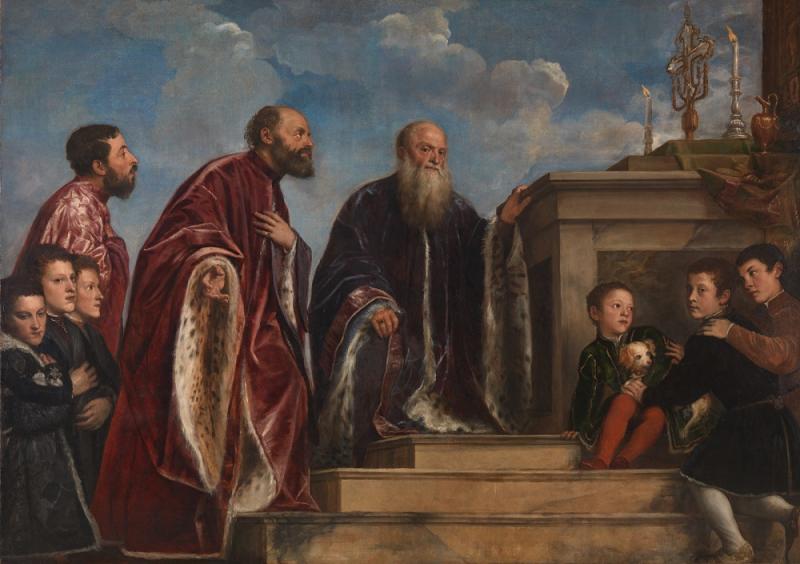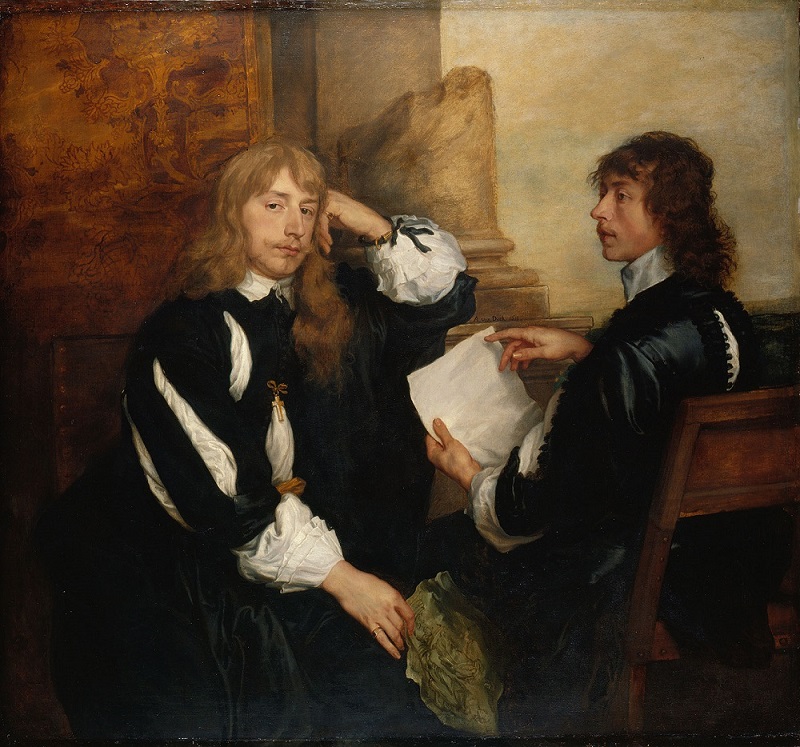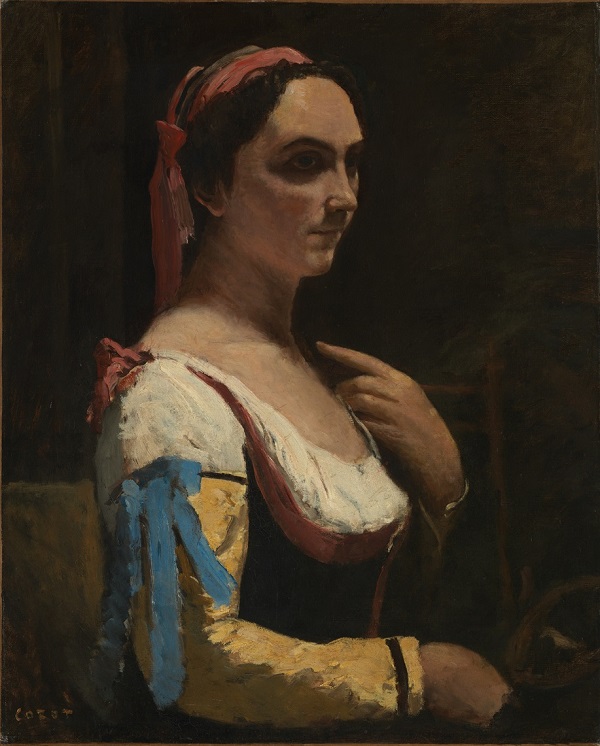Painters' Paintings, National Gallery | reviews, news & interviews
Painters' Paintings, National Gallery
Painters' Paintings, National Gallery
A glimpse inside artists' collections offers fresh insight into their own work

The huge and gorgeous Titian, The Vendramin Family, c.1540-c.1560, displays a frieze of males of all ages, three or four generations – and an adorable lap dog held close by the youngest boy – in marvellously sumptuous costume. The painting is surrounded with portraits by an ardent admirer of Titian's, Anthony van Dyck, our interest in the Titian deepened by the fact that Van Dyck once owned it.
These consummate portrait painters are separated by nearly a century but we are told that Van Dyck revered his Venetian predecessor. We can see how the Flemish painter translated and transposed into his own portraiture echoes of his close study of Titian, whose paintings he had owned in such number that his collection was referred to as a cabinet of Titian.
 A rarely-seen Van Dyck self-portrait from a private collection is reminiscent of Titian’s Portrait of Gerolamo (?) Barbarigo, c.1510. Now one of the National Gallery’s superb group of Titians, Van Dyck may well have owned either the painting or an engraving after the image.
A rarely-seen Van Dyck self-portrait from a private collection is reminiscent of Titian’s Portrait of Gerolamo (?) Barbarigo, c.1510. Now one of the National Gallery’s superb group of Titians, Van Dyck may well have owned either the painting or an engraving after the image.
There is also Van Dyck’s own double portrait of the melancholy poet Thomas Killigrew, in mourning for his wife, next to an aristocratic friend, its extraordinary sense of life profoundly lived by these two young intellectuals, captured in all its sadnesses and joys. Wrenching this group of Titians and Van Dycks from several collections and putting them together somehow throws light on both artists: seeing what Van Dyck saw in Titian enables us in turn to see more in Van Dyck (pictured above right: Anthony Van Dyck, Thomas Killigrew and William, Lord Crofts[?],1638).
Degas was notorious as a collector, continually buying and selling to acquire better things; he was absorbed with the art of his contemporaries from Manet to Cézanne, Sisley and Pissarro, and wished to support them, while also infatuated with his French predecessors, Delacroix and Ingres. There are examples here, and the comparison with Degas himself amplifies his own preoccupation with portraying the human: on view are two introspective self-portraits. In his own landscapes and those he collected we are aware of an interest in framing devices, vistas and horizons.
An intense admiration for Manet led Degas to perform a real service to his work, by assembling as many fragments as he could of the dismembered and politically contentious The Execution of Maximilian, c. 1867-8, a subject Manet had turned to several times. Cézanne’s small study Bather with Outstretched Arm, 1883-1885, the young boy both tentative and appealing, is now owned by Jasper Johns, passed from artist to artist.
Matisse too nearly bankrupted himself buying art, writing of Cézanne’s small Three Bathers, 1879-1882, which he owned for decades, that it had sustained him morally, providing him with both strength and perseverance. Picasso’s ghost is here, too, in the form of two canvases that been owned by Matisse.
 Did these artists acquire for pleasure or for instruction or both? Sir Joshua Reynolds thought owning paintings by Titian, Van Dyck and Rembrandt was the best kind of wealth. And he was not above investigating the physical properties of the paintings he owned, and sometimes even adding to them. Works of art are “models you are to imitate, and at the same time rivals you are to combat”, said Reynolds, an artist who was master of his own publicity. Lucian Freud said that he looked to certain works of art for help, just as though he were visiting a doctor.
Did these artists acquire for pleasure or for instruction or both? Sir Joshua Reynolds thought owning paintings by Titian, Van Dyck and Rembrandt was the best kind of wealth. And he was not above investigating the physical properties of the paintings he owned, and sometimes even adding to them. Works of art are “models you are to imitate, and at the same time rivals you are to combat”, said Reynolds, an artist who was master of his own publicity. Lucian Freud said that he looked to certain works of art for help, just as though he were visiting a doctor.
Freud is the catalyst for this powerful show; he had bought Corot’s striking Italian Woman, c.1870 (pictured left), at the turn of the century, and left this affecting and emotional portrait to the National Gallery in gratitude for his family’s escape from Nazi Germany to London. And here too is a Cézanne, a brothel scene, its composition and perhaps even some emotion, woven almost seamlessly into a large Freud group portrait, After Cézanne, 1999-2000, resident now in Australia’s National Gallery. Freud, who had studied art as a boy in Suffolk, had a long and evolving appreciation for Constable, acting indeed as a curator for a large exhibition in Paris in 2002: and here is a slightly naïve but touchingly luminous Constable portrait. His own self-portrait, painted when he was 79, echoing something of the Corot which he already owned, is called Reflection, and is a searing no-holds-barred look at the artist as an old man.
This show, welcome as it is, is but a tiny sample of artists’ obsessions with art. Wandering through the centuries we do get a sense of how art into art does go; we see more in both the works they collected, and in their own work. Every picture here tells a story not only about its creator, but about the art of its collector. It is a series of painless and wholly enjoyable lessons about how to look, through our own eyes and those of an artist. Whenever there has been money to spare, and often when there wasn’t, artists have acquired. The intensity with which an artist can absorb what he admires in a work of art he owns makes for a fascinating, intimate relationship.
- Painters' Paintings: From Freud to Van Dyck at the National Gallery until 4 September
- Read more visual art reviews on theartsdesk
rating
Explore topics
Share this article
The future of Arts Journalism
You can stop theartsdesk.com closing!
We urgently need financing to survive. Our fundraising drive has thus far raised £33,000 but we need to reach £100,000 or we will be forced to close. Please contribute here: https://gofund.me/c3f6033d
And if you can forward this information to anyone who might assist, we’d be grateful.

Subscribe to theartsdesk.com
Thank you for continuing to read our work on theartsdesk.com. For unlimited access to every article in its entirety, including our archive of more than 15,000 pieces, we're asking for £5 per month or £40 per year. We feel it's a very good deal, and hope you do too.
To take a subscription now simply click here.
And if you're looking for that extra gift for a friend or family member, why not treat them to a theartsdesk.com gift subscription?
more Visual arts
 Help to give theartsdesk a future!
Support our GoFundMe appeal
Help to give theartsdesk a future!
Support our GoFundMe appeal
 Electric Dreams: Art and Technology Before the Internet, Tate Modern review - an exhaustive and exhausting show
Flashing lights, beeps and buzzes are diverting, but quickly pall
Electric Dreams: Art and Technology Before the Internet, Tate Modern review - an exhaustive and exhausting show
Flashing lights, beeps and buzzes are diverting, but quickly pall
 ARK: United States V by Laurie Anderson, Aviva Studios, Manchester review - a vessel for the thoughts and imaginings of a lifetime
Despite anticipating disaster, this mesmerising voyage is full of hope
ARK: United States V by Laurie Anderson, Aviva Studios, Manchester review - a vessel for the thoughts and imaginings of a lifetime
Despite anticipating disaster, this mesmerising voyage is full of hope
 Lygia Clark: The I and the You, Sonia Boyce: An Awkward Relation, Whitechapel Gallery review - breaking boundaries
Two artists, 50 years apart, invite audience participation
Lygia Clark: The I and the You, Sonia Boyce: An Awkward Relation, Whitechapel Gallery review - breaking boundaries
Two artists, 50 years apart, invite audience participation
 Mike Kelley: Ghost and Spirit, Tate Modern review - adolescent angst indefinitely extended
The artist who refused to grow up
Mike Kelley: Ghost and Spirit, Tate Modern review - adolescent angst indefinitely extended
The artist who refused to grow up
 Monet and London, Courtauld Gallery review - utterly sublime smog
Never has pollution looked so compellingly beautiful
Monet and London, Courtauld Gallery review - utterly sublime smog
Never has pollution looked so compellingly beautiful
 Michael Craig-Martin, Royal Academy review - from clever conceptual art to digital decor
A career in art that starts high and ends low
Michael Craig-Martin, Royal Academy review - from clever conceptual art to digital decor
A career in art that starts high and ends low
 Van Gogh: Poets & Lovers, National Gallery review - passions translated into paint
Turmoil made manifest
Van Gogh: Poets & Lovers, National Gallery review - passions translated into paint
Turmoil made manifest
 Peter Kennard: Archive of Dissent, Whitechapel Gallery review - photomontages sizzling with rage
Fifty years of political protest by a master craftsman
Peter Kennard: Archive of Dissent, Whitechapel Gallery review - photomontages sizzling with rage
Fifty years of political protest by a master craftsman
 Dominique White: Deadweight, Whitechapel Gallery review - sculptures that seem freighted with history
Dunked in the sea to give them a patina of age, sculptures that feel timeless
Dominique White: Deadweight, Whitechapel Gallery review - sculptures that seem freighted with history
Dunked in the sea to give them a patina of age, sculptures that feel timeless
 Bill Viola (1951-2024) - a personal tribute
Video art and the transcendent
Bill Viola (1951-2024) - a personal tribute
Video art and the transcendent

Add comment